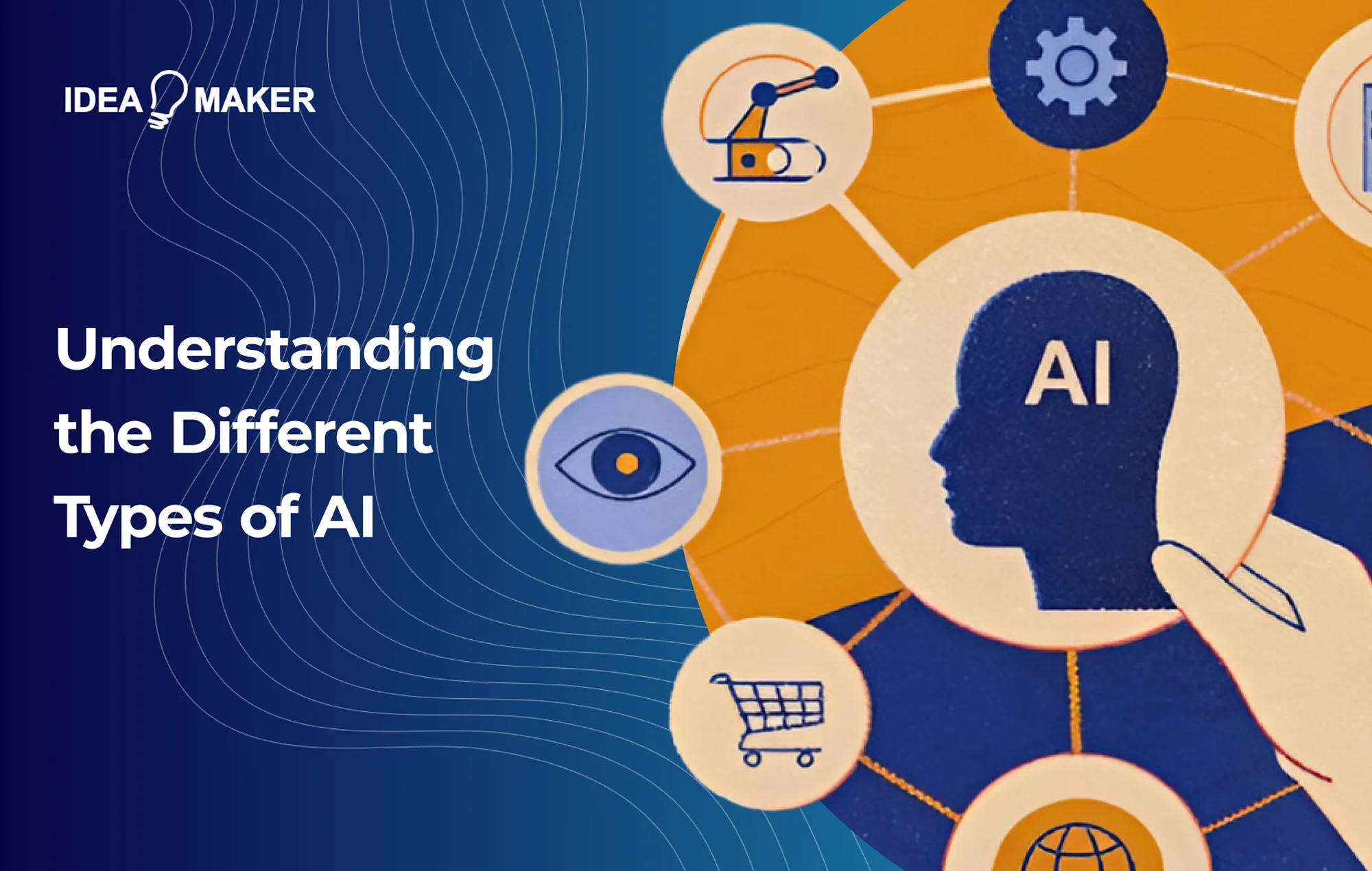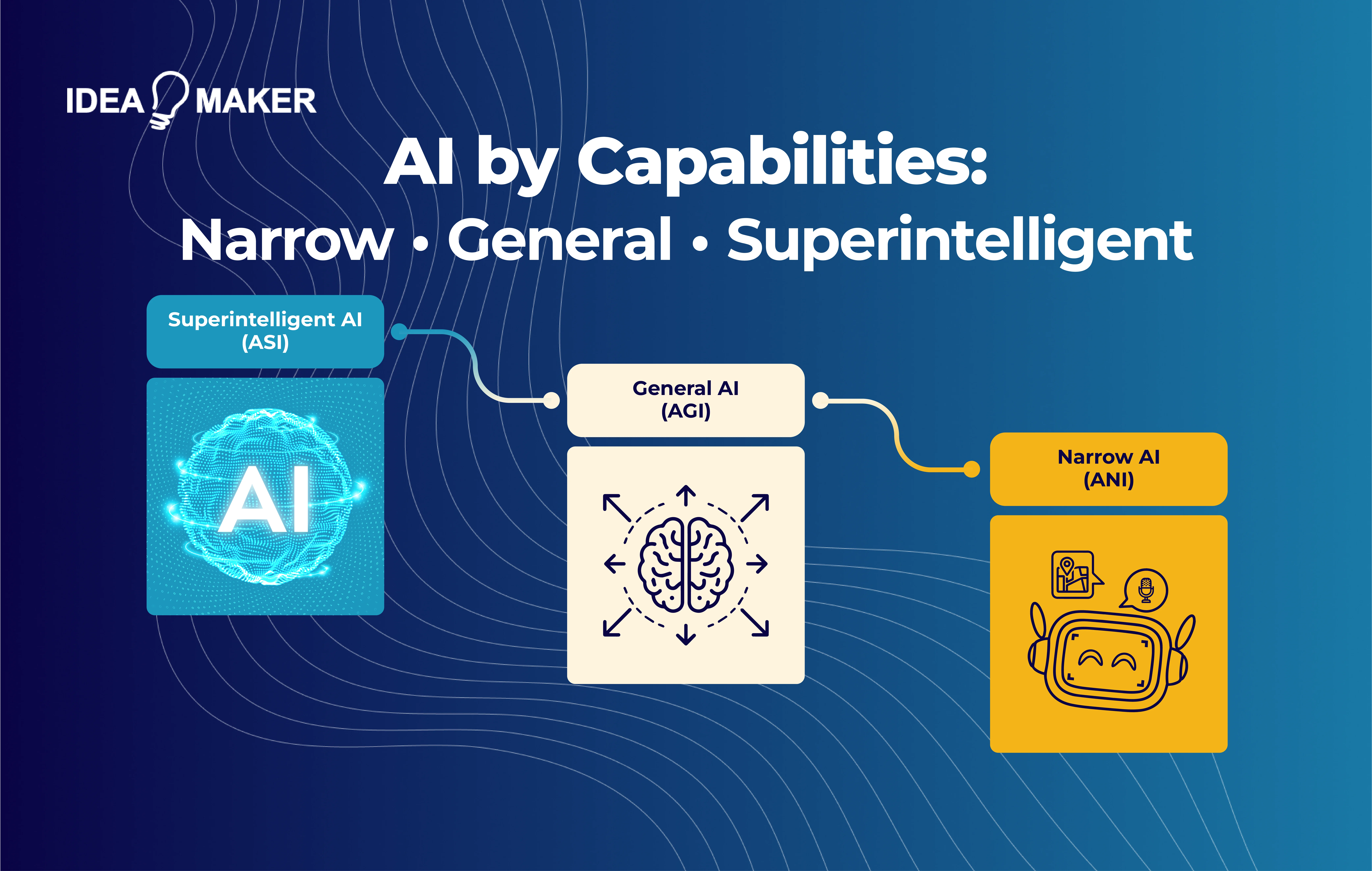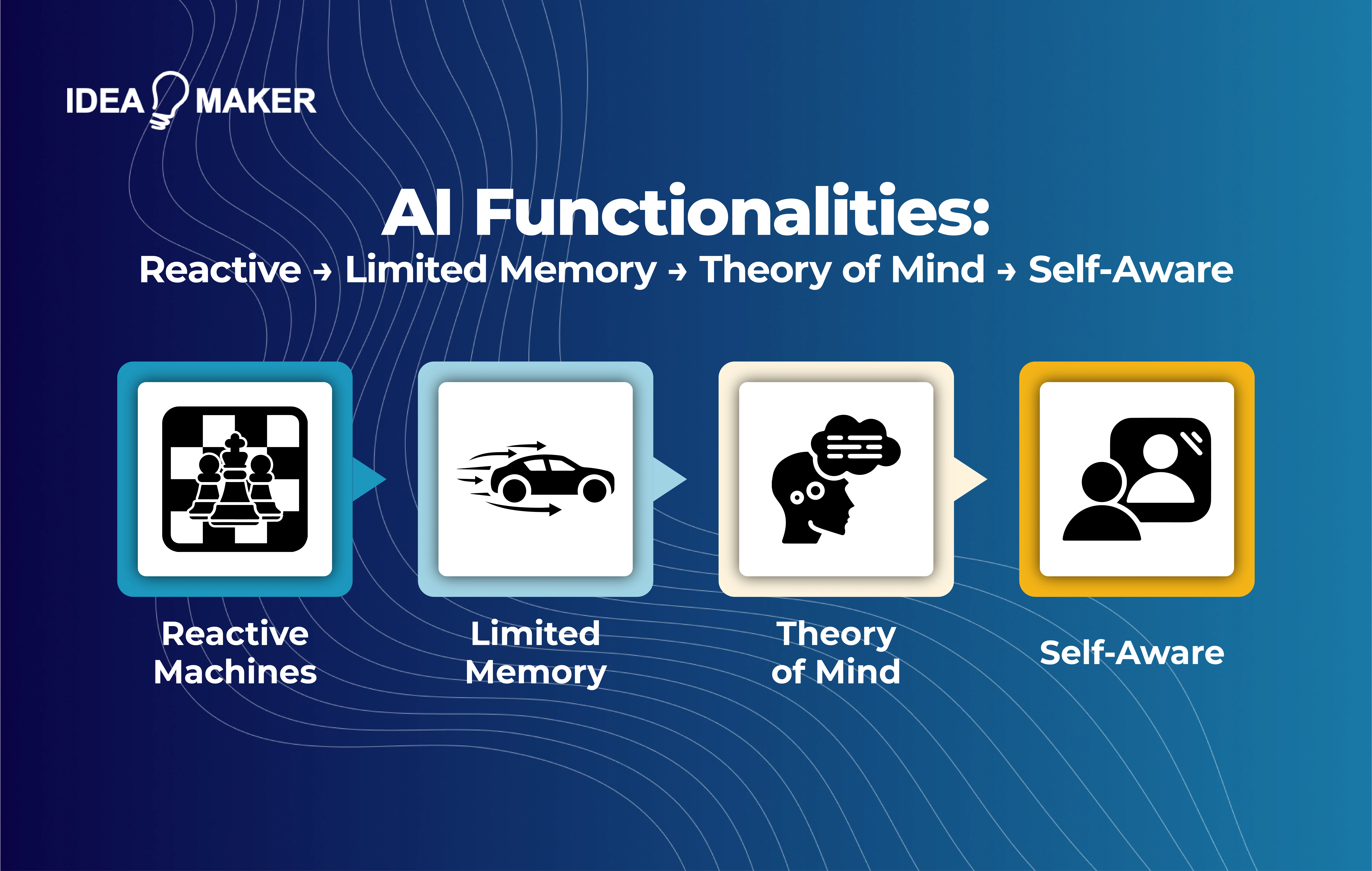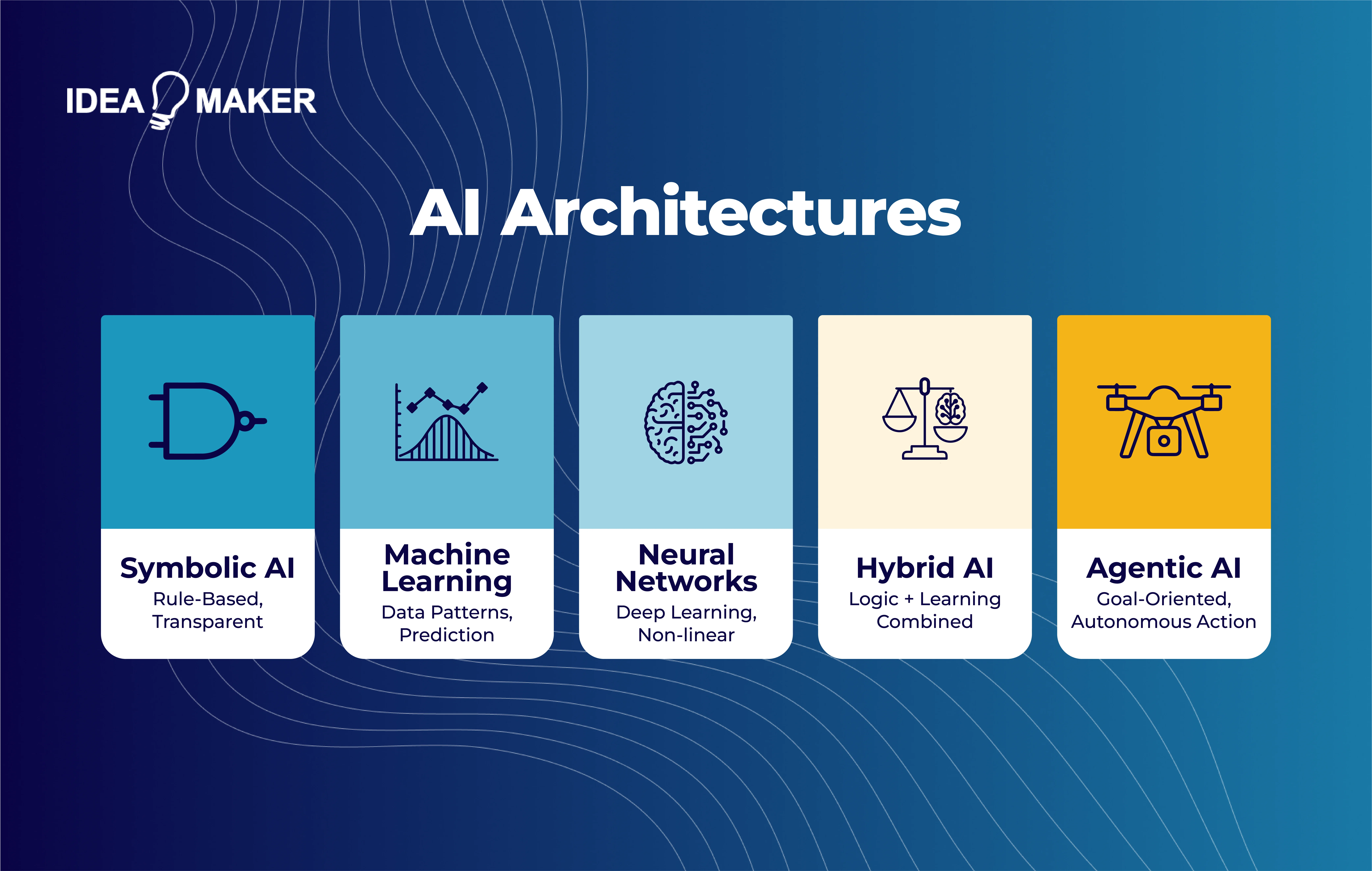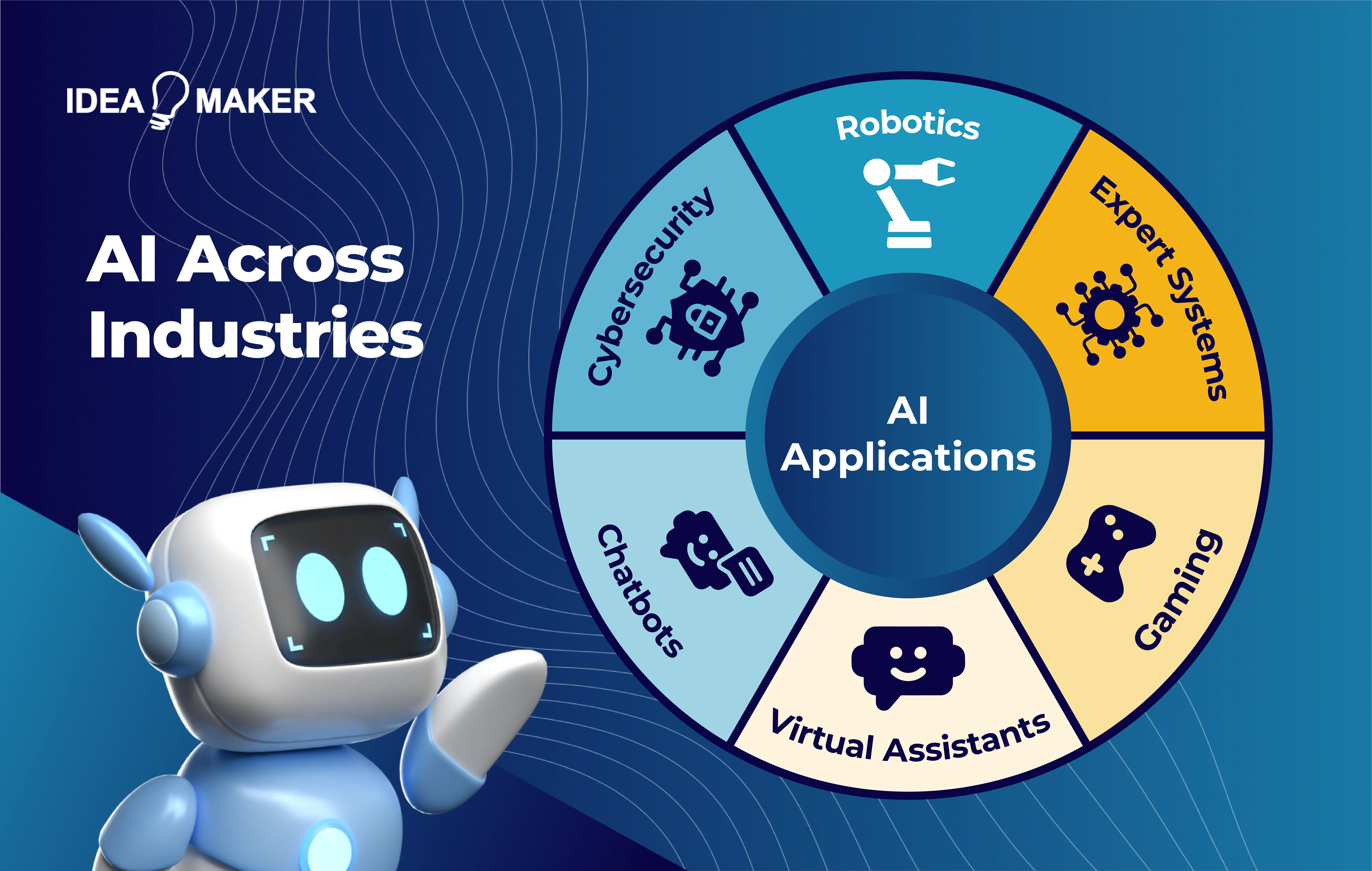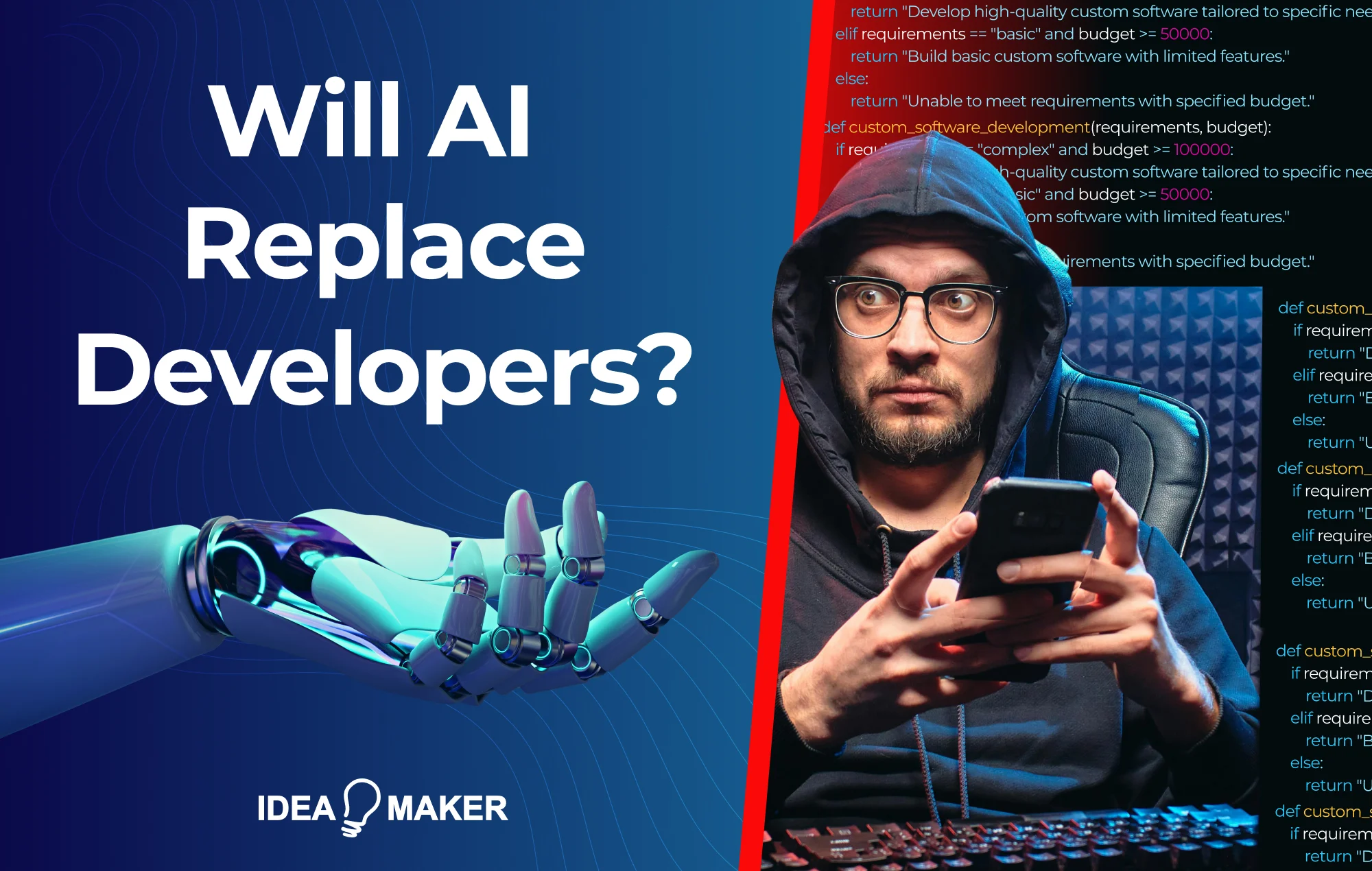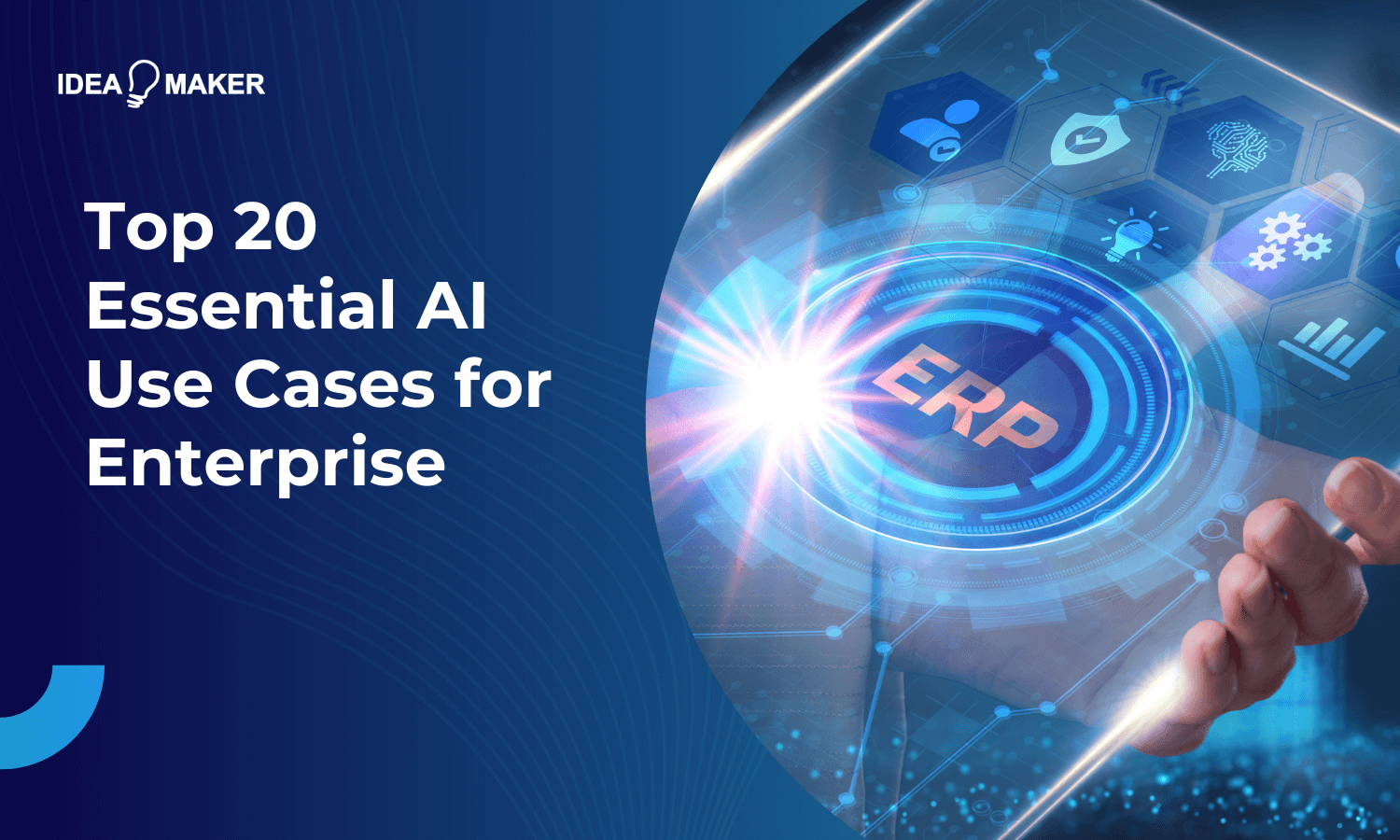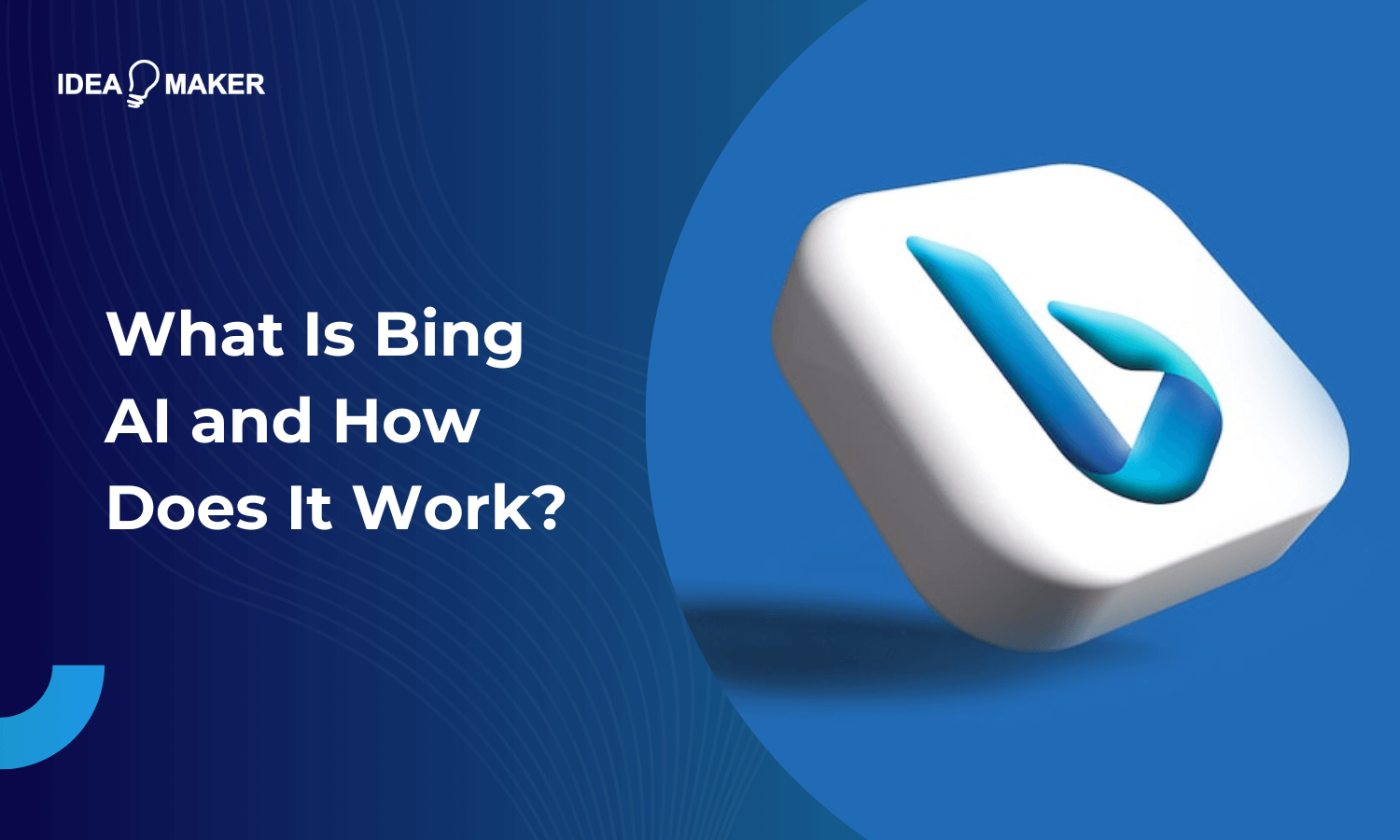Artificial Intelligence is no longer an experimental technology; it’s a competitive differentiator that reshapes the entire industry’s operations. According to a McKinsey report, in 2024, 78% of organisations utilize AI in at least one business function. In fact, most large-scale AI projects today blend two or more approaches, such as predictive analytics with rule-based decision-making.
But not every AI approach fits every business problem. The wrong choice can waste millions, stall innovation, and undermine transformation efforts. To lead effectively, you need a clear understanding of what each AI type can achieve, where it excels, and where it falls short.
This guide simplifies the complex AI landscape into practical categories by capability, functionality, and technology, paired with real-world applications and strategic takeaways. Think of it as your blueprint for choosing the right AI mix to drive innovation, operational efficiency, and sustainable growth.
Table of Contents
What Are the Different Types of AI?
At its core, AI refers to systems capable of performing tasks that typically require human intelligence, such as reasoning, learning, and decision-making.
However, not all AI is created equal its power, scope, and adaptability vary widely depending on the category it falls into.
By exploring AI capabilities (what it can do), functionalities (how it operates), architectures (how it’s built), and learning methods (how it learns), we can form a complete picture of AI’s role today and its potential tomorrow.
Classification of AI by Capabilities
We can categorize AI systems based on their capability to achieve tasks and automatically learn and adapt to new challenges once they emerge. This categorization answers the question: How intelligent is the AI, and how broadly can it apply its knowledge?
Narrow AI (Artificial Narrow Intelligence – ANI / Weak AI)
Narrow AI systems excel at performing specific tasks for which they have been explicitly designed, but they lack understanding or awareness beyond those tasks. These models are trained on massive datasets for well-defined tasks and usually beat humans in narrow domains. But they don’t apply the same thinking outside that context.
For instance, a model trained to identify fraudulent transactions can’t respond to customer service questions or drive a car. Narrow AI operates under fixed rules or learned patterns and has no consciousness or general reasoning ability. It’s the most common type of AI in use today.
Examples:
- Smartphone security facial recognition systems
- ChatGPT or other LLMs for customer service
- Google Maps’ route optimization algorithms
- Spam filters in email systems
- Devices for predictive maintenance in IIoT
- Voice assistants like siri and Alexa
Strong AI (Artificial General Intelligence – AGI / Strong AI)
AGI is the theoretical type of AI that can comprehend, learn, and apply knowledge to a variety of tasks similar to a human being. General AI would be able to think, quickly adjust to unfamiliar surroundings, and make multi-step decisions with little guidance. AGI systems would not need to be retrained for specific tasks and could transfer knowledge across domains.
Although AGI does not currently exist, the development of AGI is presently under active research as a long-term goal of AI research. At AGI, we’d finally reach a turning point: machines that can think abstractly, reflect on their experiences, and learn independently across all domains, not just those they were trained on.
Examples (theoretical/future-use):
- A digital researcher capable of designing and running their own experiments.
- A general-purpose household robot that cooks, cleans, and teaches itself new skills as needed.
- AI tutors that adapt to each student’s learning style and subject matter.
- Cross-domain medicine consultants for diagnosis, treatment, and new therapeutic discovery
Superintelligent AI (ASI)
Artificial Superintelligence goes a step beyond AGI. This category of AI denotes an intelligence that would surpass the best human intellect across the board, from creativity and emotional intelligence to scientific reasoning. ASI wouldn’t just handle duties more quickly and reliably, but could also make decisions that humans might struggle to comprehend. It’s a faraway and highly speculative future, but one with massive implications. Discussions of ASI often emphasize the issues of control, alignment, and existential risk, because it could conceivably evade human oversight.
Examples (hypothetical):
- An AI that is capable of inventing new technologies or of curing diseases without any human inspiration.
- A planetary-scale resource manager for the global economy.
- Real-time crisis prevention system that compares responses between countries to avoid escalation of geopolitical conflicts.
- AI capable of autonomous scientific discovery and ethics-aware decision-making
Classification of AI by Functionalities
Another classification of AI is based on how they sense, learn from, and act in their environment. This category focuses on the cognitive abilities of AI, ranging from simple pattern matching to the potential for self-awareness.
Reactive Machines
Reactive machines rely solely on current input and do not store or learn from previous experiences. These systems follow a set of pre-defined rules and respond in a consistent manner to given input. They have no memory or understanding of context.
Example: IBM’s Deep Blue chess computer would process board positions in real time without learning from previous games.
Limited Memory AI
This type of AI makes decisions based on historical data for a limited period. Most AI in use today falls into this category. These systems are trained on big data and learn to adapt their output according to past experiences. Yet, they lack a mechanism to store past interactions or to continue learning once deployed.
Example: Autonomous vehicles that observe recent traffic history and the movement of other cars to react instantly.
Theory of Mind AI
Theory of Mind AI understands human emotions, intentions, beliefs, and social cues to interact with individuals through a more natural and human-like manner. This AI must have the capacity to model mental states. While foundational research exists, this kind of AI has not yet been realized.
Example (fictional): A healthcare assistant whose character adjusts in tone or advice to reflect a patient’s mood or level of anxiety.
Self-aware AI
AI with self-awareness is a quite theoretical and science fiction stage of functionality. Such systems would possess a sense of self, consciousness, and self-awareness. If such AI could exist, then it could have self-referential thoughts, subjective experience, and perhaps power. This is not something we have now, and there are a lot of philosophical and ethical concerns around this.
Example (fictitious): An AI that can assess its own limitations and autonomously choose to pause or upgrade its processes based on self-reflection.
Classification by Architectural Style
AI systems are also categorized by their architectural design, i-e, the way they process information, represent knowledge, and learn. This classification reveals how different AI systems are built and how they operate, from rule-based logic engines to data-driven learning models.
Symbolic & Rule‑Based AI
A rule-based form of AI, symbolic AI uses logic and predefined rules to make decisions. It represents knowledge in terms of distinct symbols and uses reasoning mechanisms to derive conclusions. These systems have complete transparency and are suitable for situations where the transparency of outputs is important.
For example, A tax compliance tool that follows if-then logic to apply deduction rules.
Machine Learning (Classical ML)
Traditional machine learning models learns patterns from data on their own, rather than being explicitly programmed. It utilizes models like decision trees, support vector machines, and logistic regression. Such algorithms perform well on prediction and classification-based problems where there are large amounts of data to learn from.
Example: A credit scoring model for loan defaults based on historical customer data.
Connectionist AI (or Neural Networks & Deep Learning)
Connectionist AI is inspired by the structure of the human brain and is modelled in the same manner. It uses artificial neural networks to estimate complex, non-linear relationships. Deep learning is a subset of this technique that constructs deep stacks of neuron layers to make sense of unstructured data, such as images, text, or speech. According to Fortune Business Insights, the global deep learning market was valued at $24.53 billion in 2024 and is projected to reach $279.60 billion by 2032.
For example, A speech recognition system that converts spoken language into text in real time.
Hybrid & Neuro‑Symbolic AI
Hybrid AI combines symbolic reasoning with machine learning to get logical transparency and data-driven adaptability. Neuro-symbolic systems are particularly useful in high-stakes environments where accuracy and explainability must coexist.
Example: An AI legal assistant that uses deep learning to generate insights from documents and applies symbolic logic to verify that contract terms are met.
Agentic AI
Agentic AI describes systems that not only process information but also take actions, set goals, make decisions, and change their behaviour in response to feedback from the environment. Agentic systems are not fixed pipelines as traditional models are; rather than acting once, perfectly, agentic systems react, plan, act, and learn in a continual loop. These agents usually have components like memory, planning modules, and reward systems integrated to function independently on a long time scale. The AI Agents Market size was valued at USD 5.25 billion in 2024 and is projected to grow from USD 7.84 billion in 2025 to USD 52.62 billion by 2030.
For Example, an AI-drone capable of autonomously mapping disaster areas, moving around obstacles, and autonomously updating its flight plan in response to a changing terrain.
AI by Learning Methods
Another important classification of AI is based on how it learns from data. The learning paradigm defines how the AI system is trained, what data it requires, and how easily it can be retrained for a new task.
Supervised Learning
The AI models in supervised learning learn from labeled data: For each input, the correct output is provided in the training data. During training, the model is trained to make predictions about the output based on the input, with minimal errors in the predictions. This scheme works well in classification and regression problems if there is enough correct historical data available.
For example, an email spam filter that has been trained on records indicating spam or non-spam and is subsequently tasked to classify new emails.
Unsupervised Learning
Unsupervised learning is the process of training on unlabeled data, allowing the model to discover hidden patterns, groupings, or structures without being specifically directed. It’s perfect for doing exploratory analysis, as well as data preprocessing, dimensionality reduction, and anomaly detection when labeling is infeasible or limited.
For example, A model for segmenting customers by behavior even before the company knows who they are.
Semi‑supervised Learning
Semi-supervised learning uses a small number of labeled instances and a large number of unlabeled instances. It provides a balance between the overall performance expense of complete labeling. This method is suitable for tasks where human annotation is costly or time-consuming, such as in medical imaging.
For example, a Machine learning model to classify diseases based on a few annotated X-rays and thousands of unlabeled scans.
Reinforcement Learning
In reinforcement learning, agents are trained such that their favorable and unfavorable actions are reinforced and corrected, respectively, in a well-defined environment through a reward and penalty system. The agent learns through trial-and-error by updating its policy such that the generated behavior leads to high cumulative rewards. It’s useful for making decisions in real time within dynamic systems.
For example, the robotic arm learns to separate objects based on their color by testing them out and getting feedback.
Comparing AI Types by Key Traits
When there are numerous overlapping classifications by capability architecture and learning method, it’s helpful to see how typical types of AI differ across practical traits. The following table provides a comparison for a handy, quick reference guide for technical leaders and teams to match the best type of AI to their business strategies.
| Type | Learning Style | Use Case Domains | Human-Likeness | Autonomy |
| Narrow AI | Task-specific | E-commerce, Healthcare | Low | Limited |
| General AI | General-purpose | Hypothetical | High | High |
| Symbolic AI | Rules/Logic | Compliance, Planning | Medium | Medium |
| ML-Based AI | Data-driven | Most modern AI | Medium | Medium |
| Generative AI | Predictive/Creative | Media, Code, Design | High | Medium |
How Different AI Types Power Product Features: Common Use Cases?
AI in Robotics
- Warehouse automation: AI robots utilize computer and vision path planning to sort, pick, and move inventory with precision to reduce human workload and speed up order fulfillment.
- Self-driving cars: Reinforcement learning can teach driving agents to learn from real-time inputs such as traffic, weather, and road conditions in order to drive safely and efficiently.
- Surgical assistance: AI-powered robotic systems aid surgeons in maintaining steady instruments and accommodating real-time movements during surgeries. Interestingly, AI has reduced complications by up to 30% and recovery times by an average of 20%.
Expert Systems
- Medical diagnosis: Expert systems based on rules process a combination of symptoms and patient history to suggest likely diagnoses to assist with speedy decision-making in healthcare.
- Regulatory compliance: In banking and insurance, expert systems apply fixed rules to monitor transactions and flag compliance violations to ensure consistent adherence to legal standards.
- Technical support: Many call centers and enterprise help desks utilize expert systems that provide step-by-step troubleshooting solutions to customers for enhanced error-free directions, as well as resolution times.
AI in Gaming
- Adaptive game difficulty: Reinforcement learning agents adjust strategies based on player behavior to offer a more personalized and challenging experience.
- Procedural content generation: Generative AI generates unique environments, dialogues, or story arcs to increase the replay value of the game and reduce a developer’s routine workload.
- Intelligent NPC behavior: Players can play against non-player characters with realistic reaction and decision-making abilities for seamless combat scenarios.
Virtual Assistants
- Enterprise productivity: AI assistants like Microsoft Copilot can also help professionals automate scheduling, draft emails, and even summarize documents to increase daily efficiency and reduce administrative load.
- Healthcare institutions: With a voice-controlled assistant, healthcare providers can access patient information or take notes while examining patients without using their hands. This saves time and minimizes charting fatigue.
- Smart home control: Alexa, among other consumer-focused assistants, communicates with IoT devices and allows light switches, a thermometer, and alarms to be controlled via voice command, which simplifies the user interaction.
Chatbots
- E-commerce: AI chatbots handle common inquiries, such as order tracking, returns, and payment issues, 24/7 to reduce wait times for customer support and lighten the load on human teams. According to McKinsey research on Gen AI’s economic potential, organisations using Gen AI customer service agents saw a 14% increase in issue resolution per hour and a 9% reduction in time spent handling issues.
- Banking and finance: Bots respond to account questions, transaction status, or fraud notification in a secure real-time conversation format that makes it easier for consumers to access services.
- EdTech apps: AI transforms the educational sector through chatbots that tutor students through course material, provide quizzes, and answer frequently asked questions to allow for personalized, self-paced learning.
AI in Cybersecurity
- Real-time threat detection: ML models can monitor logs, network traffic, and user actions to detect any anomalies related to unauthorized access or lateral movement to detect attacks quickly. The integration of AI into cybersecurity systems has been shown to increase the speed of breach detection by up to 63%.
- Phishing Prevention: NLP systems analyze incoming emails to prevent fraud-laced language and identify relevant patterns of deception to redirect emails before they reach users.
- Automated incident response: AI systems automatically detect and isolate compromised devices, trigger predefined containment workflows, and suggest next steps to help security teams respond faster and limit the spread of an attack.
Ethical and Strategic Implications of AI
As AI becomes more integrated into decision-making and public systems, it’s also giving rise to ethical and strategic risks. The following are some ethical and strategic concerns organizations must address before integrating AI into their businesses:
Bias in decision-making:
If AI systems are trained on biased or incomplete data, it can lead to unfair results. The result can be more severe in hiring, lending, or law enforcement, which carry legal and reputational risks. For example, Amazon had to scrap its AI recruiting tool after it was discovered to discriminate against female candidates.
Lack of transparency:
Most AI systems are like black boxes, which makes it difficult for humans to understand how they make decisions. This reduces accountability and undermines user confidence. To tackle this, the AI systems must be made explainable to uncover their decision-making process and address issues early.
Security vulnerabilities:
AI may be used against an organization in the form of adversarial attacks or data poisoning. Hence, strong security practices must be followed during the development of such systems.
Ownership and accountability:
When AI systems make decisions of their own, it’s hard to determine who owns mistakes. It becomes a challenge for both legal liability and risk management.
Strategic dependence on vendors:
Relying heavily on third-party AI platforms can create lock-in, limit flexibility, and raise concerns over data privacy, compliance, and control.
How AI Will Shape Our Future?
Workforce Redefinition Through Intelligent Automation
AI will rapidly transform operations by automating repetitive tasks, such as data entry, reporting, and customer support, in fields like finance, healthcare, logistics, and manufacturing. This doesn’t mean substituting every job, but rather reallocating human roles to more creative, analytical, and decision-making tasks. These companies will have to invest heavily in training their employees for new functions, such as AI operations, prompt engineering, data ethics, and human-AI collaboration. The workforce of the future will need to adapt rapidly, and companies that take the initiative in re-skilling them will be many steps ahead.
Faster Scientific Progress and Industry Innovation
In future drug development, AI can be used to identify candidate compounds and predict trial outcomes before moving into the lab. As AI is more heavily incorporated into research workflows, it will function as a discovery engine to formulate hypotheses and optimize experiments to find patterns across genomes, chemistry, or physics. This, in turn, will result in faster, more affordable breakthroughs across fields, as well as companies’ ability to bring products to market.
The Transformation of Global Power, Governance, and Regulation
Countries dominating the development of AI will steer the economy, defense, and trade patterns worldwide. But with this power comes responsibility. Policymakers need to get some control over pressing issues. This includes algorithmic bias, A.I. surveillance, misinformation, and autonomous weapons. It will also require international cooperation to develop standard guidelines for the responsible use of AI.
How Idea Maker Agency Delivers AI Solutions
Strategy & Discovery Phase
Any successful AI implementation should begin with well-defined business goals. And that is why we, at Idea Maker, start by focusing on high-leverage areas where AI can provide tangible value, either by automating internal processes, enhancing the customer experience, or developing new product features. We conduct a technical deep dive, assess your data readiness level, and help you discover tangible AI use cases that contribute to long-term returns on your investment (ROI).
Architecture & Engineering Expertise
Our group develops production-ready, scalable AI systems tailored to meet your specific needs. Whether it’s to create data pipelines, integrate with 3rd party APIs, or deploy custom machine learning models, we adhere to best practices for security, performance, and maintainability. We operate within AI stacks such as computer vision, natural language processing, and predictive analytics to design solutions that integrate smoothly within your current infrastructure.
Ongoing Support & AI Governance
Even after deployment, we provide continuous support for the trained model, including ongoing performance surveillance, retraining, and compliance updates. We also establish internal AI governance mechanisms to ensure your systems remain ethical, explainable, and compatible with evolving business and regulatory needs.
Frequently Asked Questions
What’s the difference between narrow and general AI?
Narrow AI is designed for a specific task, such as language translation or fraud detection. General AI features a broad, human-like intelligence that can reason across different domains. However, it’s still not been developed yet.
Which learning method works best for anomaly detection?
Anomaly detection is primarily performed through unsupervised and semi-supervised learning, as these methods can detect outliers in the data without requiring labeled samples.
How soon could general AI become practical?
While progress continues to be made at a rapid pace, general AI is still decades away from being deployed in the real world. Reasoning, understanding common sense, and safe deployment remain significant challenges.
How do domain constraints affect model training?
Domain constraints, such as industry regulations, data availability, and operational capacity, determine how models are built and deployed. These frequently rely on custom data preprocessing, rule-based overrides, or hybrid systems using symbolic logic and ML.
What governance measures should businesses apply when using AI?
Vital KPIs include data privacy compliance, model explainability, bias audits, and ongoing monitoring. Governance mechanisms ensure that AI is used ethically, safely, and legally at scale.
Final Thoughts on Understanding AI Types and Their Strategic Value
Understanding the various types of AI is crucial for making informed technology decisions that benefit your business. Because each type of AI has its strengths and weaknesses, companies should consider these factors before developing AI products. By matching the right type of AI to a specific use case, companies can innovate at speed, deliver more productivity gains, and build systems that are both scalable and responsible.
If you’re exploring how to align the right AI type with your business goals, Idea Maker offers a free AI development consultation to evaluate your needs, choose the ideal AI category, and design solutions that are practical, ethical, and built for growth.
